Research Outline: Cloud Computing Implementation at XYZ
VerifiedAdded on 2022/08/20
|5
|1021
|14
Report
AI Summary
This research outline presents a comprehensive analysis of cloud computing implementation within the hypothetical company XYZ. The study identifies key issues such as lack of IT expertise, privacy concerns, cost considerations, and governance challenges, using the Hexagon Model for evaluation. It proposes a detailed implementation plan based on the Cloud Computing Adoption Framework (CCAF), including application selection, cloud model selection, security policy understanding, vendor evaluation, SLA definition, disaster recovery planning, and phased deployment. The report also incorporates a cost/benefit analysis, ROI calculation, and feasibility analysis (economic, technical, and operational) to determine the viability of cloud adoption. The conclusion emphasizes the potential for operational efficiency and reliable backup, while highlighting the need for skilled personnel and training. The research utilizes various models and theories to provide practical recommendations for successful cloud computing adoption.
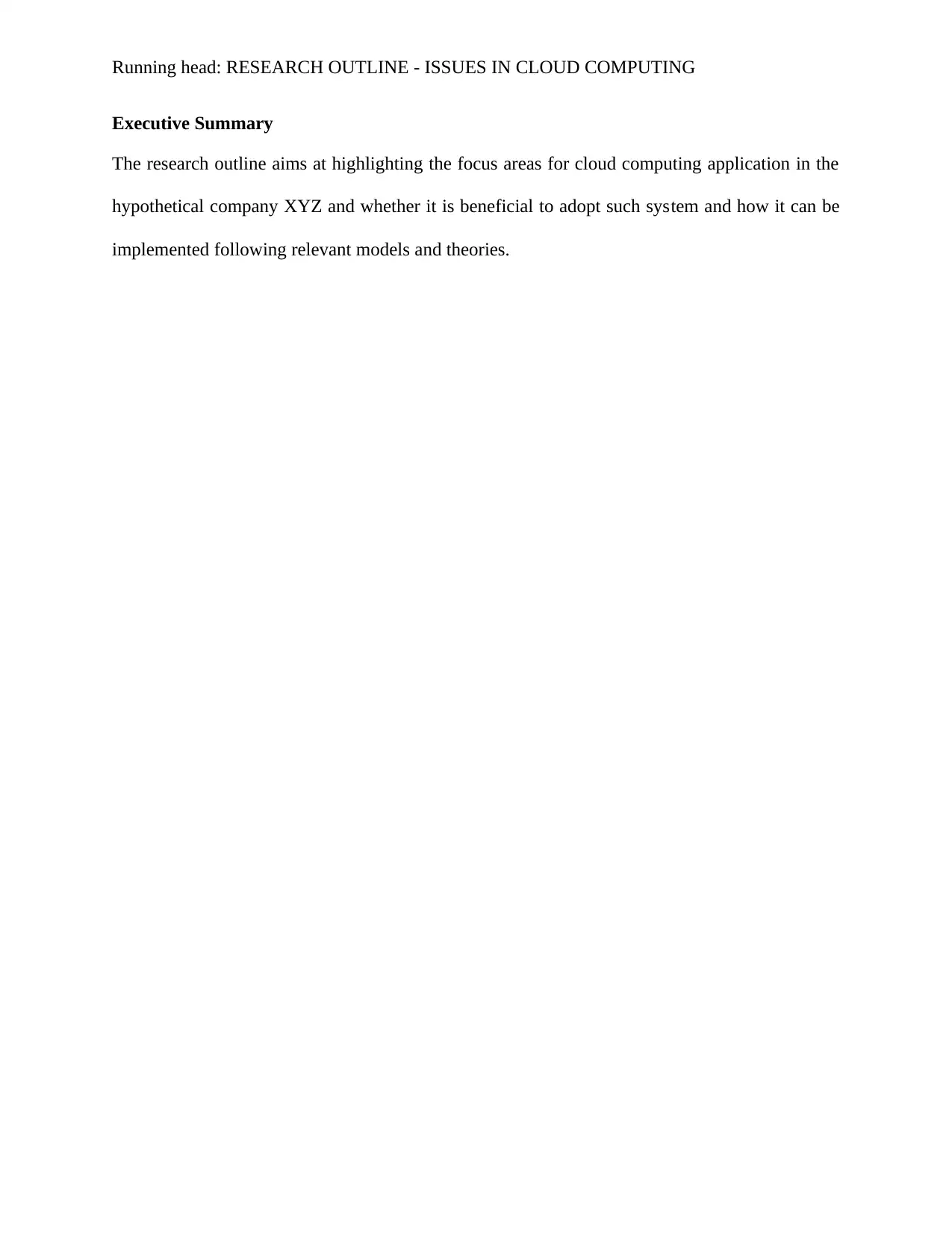
Running head: RESEARCH OUTLINE - ISSUES IN CLOUD COMPUTING
Executive Summary
The research outline aims at highlighting the focus areas for cloud computing application in the
hypothetical company XYZ and whether it is beneficial to adopt such system and how it can be
implemented following relevant models and theories.
Executive Summary
The research outline aims at highlighting the focus areas for cloud computing application in the
hypothetical company XYZ and whether it is beneficial to adopt such system and how it can be
implemented following relevant models and theories.
Paraphrase This Document
Need a fresh take? Get an instant paraphrase of this document with our AI Paraphraser
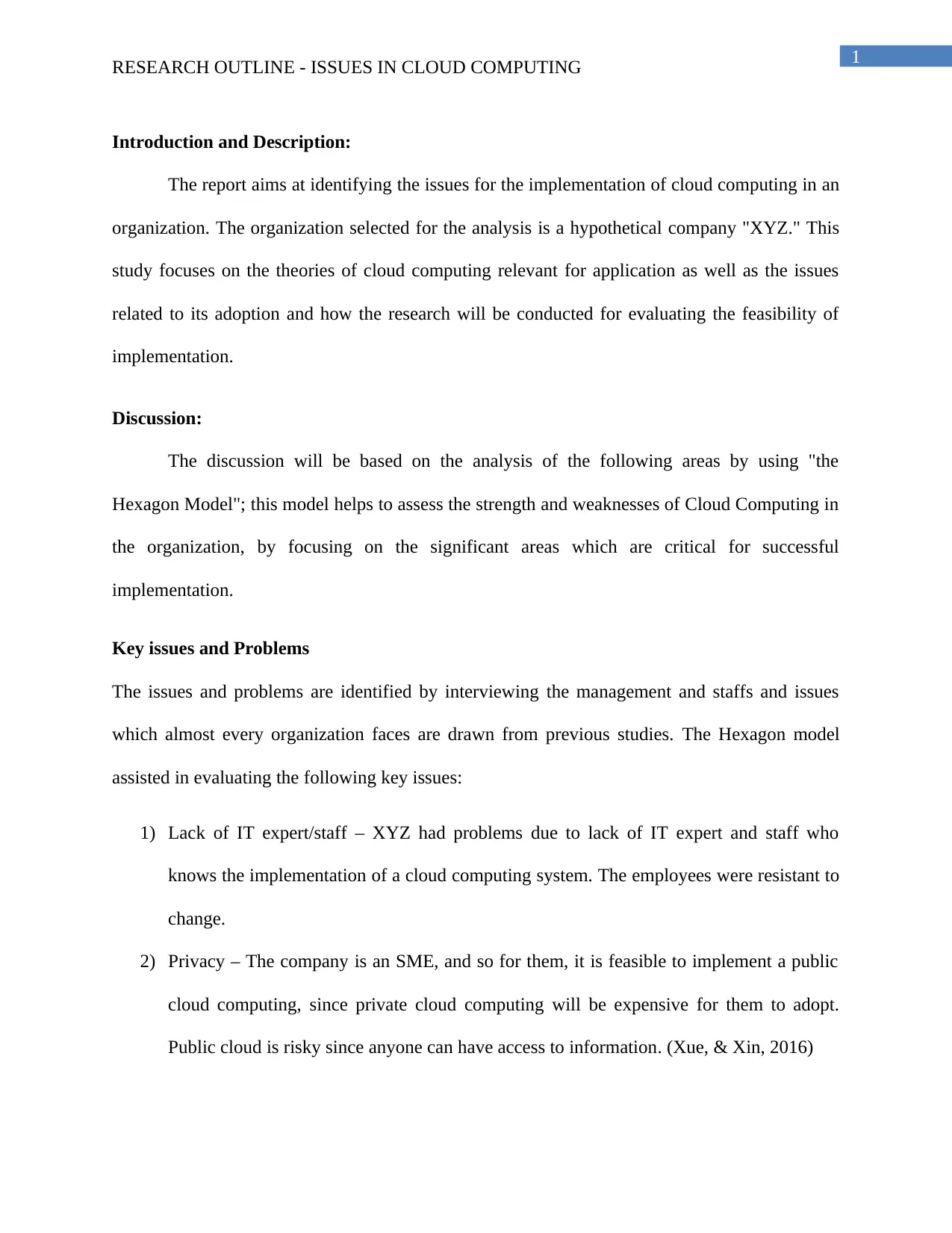
1
RESEARCH OUTLINE - ISSUES IN CLOUD COMPUTING
Introduction and Description:
The report aims at identifying the issues for the implementation of cloud computing in an
organization. The organization selected for the analysis is a hypothetical company "XYZ." This
study focuses on the theories of cloud computing relevant for application as well as the issues
related to its adoption and how the research will be conducted for evaluating the feasibility of
implementation.
Discussion:
The discussion will be based on the analysis of the following areas by using "the
Hexagon Model"; this model helps to assess the strength and weaknesses of Cloud Computing in
the organization, by focusing on the significant areas which are critical for successful
implementation.
Key issues and Problems
The issues and problems are identified by interviewing the management and staffs and issues
which almost every organization faces are drawn from previous studies. The Hexagon model
assisted in evaluating the following key issues:
1) Lack of IT expert/staff – XYZ had problems due to lack of IT expert and staff who
knows the implementation of a cloud computing system. The employees were resistant to
change.
2) Privacy – The company is an SME, and so for them, it is feasible to implement a public
cloud computing, since private cloud computing will be expensive for them to adopt.
Public cloud is risky since anyone can have access to information. (Xue, & Xin, 2016)
RESEARCH OUTLINE - ISSUES IN CLOUD COMPUTING
Introduction and Description:
The report aims at identifying the issues for the implementation of cloud computing in an
organization. The organization selected for the analysis is a hypothetical company "XYZ." This
study focuses on the theories of cloud computing relevant for application as well as the issues
related to its adoption and how the research will be conducted for evaluating the feasibility of
implementation.
Discussion:
The discussion will be based on the analysis of the following areas by using "the
Hexagon Model"; this model helps to assess the strength and weaknesses of Cloud Computing in
the organization, by focusing on the significant areas which are critical for successful
implementation.
Key issues and Problems
The issues and problems are identified by interviewing the management and staffs and issues
which almost every organization faces are drawn from previous studies. The Hexagon model
assisted in evaluating the following key issues:
1) Lack of IT expert/staff – XYZ had problems due to lack of IT expert and staff who
knows the implementation of a cloud computing system. The employees were resistant to
change.
2) Privacy – The company is an SME, and so for them, it is feasible to implement a public
cloud computing, since private cloud computing will be expensive for them to adopt.
Public cloud is risky since anyone can have access to information. (Xue, & Xin, 2016)
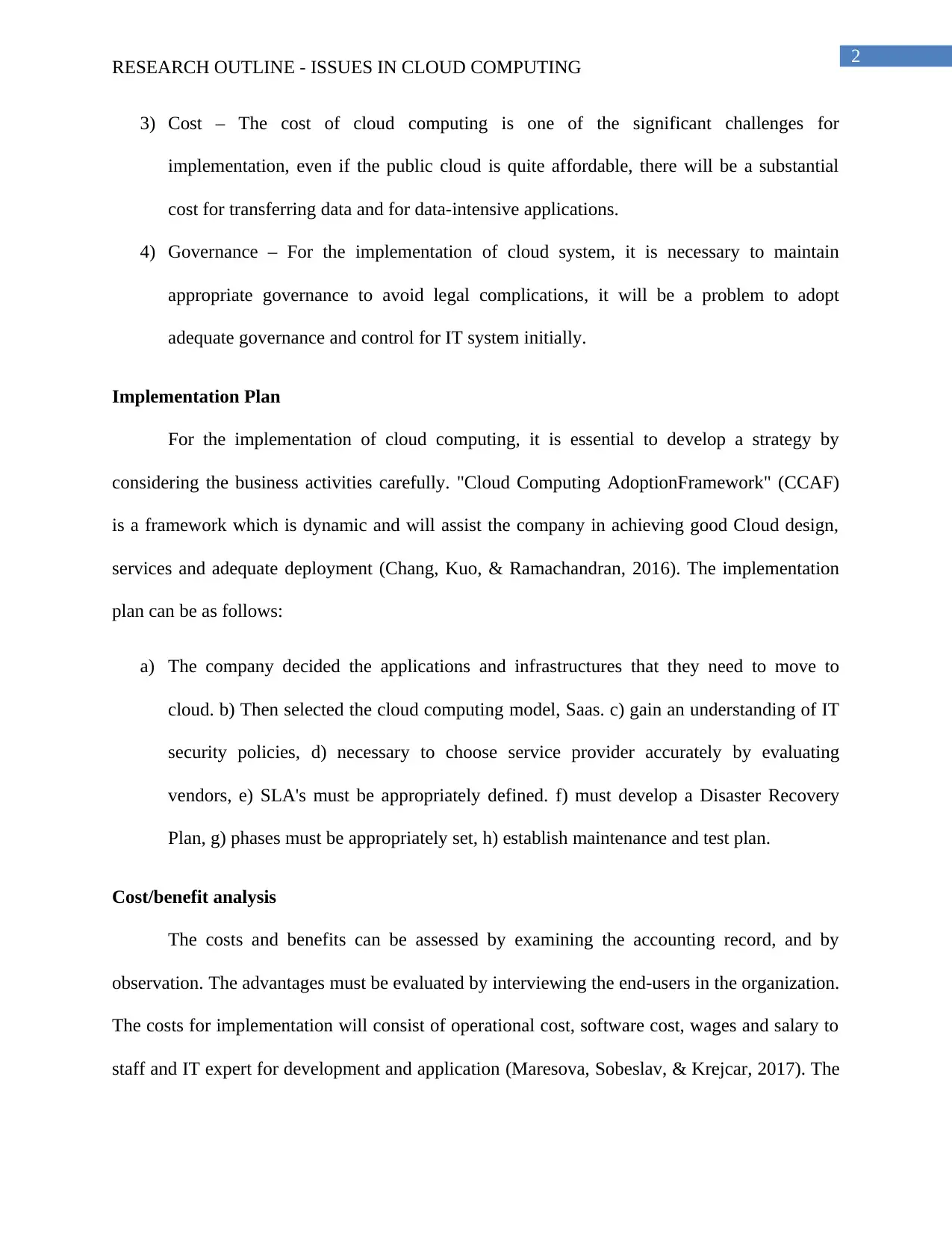
2
RESEARCH OUTLINE - ISSUES IN CLOUD COMPUTING
3) Cost – The cost of cloud computing is one of the significant challenges for
implementation, even if the public cloud is quite affordable, there will be a substantial
cost for transferring data and for data-intensive applications.
4) Governance – For the implementation of cloud system, it is necessary to maintain
appropriate governance to avoid legal complications, it will be a problem to adopt
adequate governance and control for IT system initially.
Implementation Plan
For the implementation of cloud computing, it is essential to develop a strategy by
considering the business activities carefully. "Cloud Computing AdoptionFramework" (CCAF)
is a framework which is dynamic and will assist the company in achieving good Cloud design,
services and adequate deployment (Chang, Kuo, & Ramachandran, 2016). The implementation
plan can be as follows:
a) The company decided the applications and infrastructures that they need to move to
cloud. b) Then selected the cloud computing model, Saas. c) gain an understanding of IT
security policies, d) necessary to choose service provider accurately by evaluating
vendors, e) SLA's must be appropriately defined. f) must develop a Disaster Recovery
Plan, g) phases must be appropriately set, h) establish maintenance and test plan.
Cost/benefit analysis
The costs and benefits can be assessed by examining the accounting record, and by
observation. The advantages must be evaluated by interviewing the end-users in the organization.
The costs for implementation will consist of operational cost, software cost, wages and salary to
staff and IT expert for development and application (Maresova, Sobeslav, & Krejcar, 2017). The
RESEARCH OUTLINE - ISSUES IN CLOUD COMPUTING
3) Cost – The cost of cloud computing is one of the significant challenges for
implementation, even if the public cloud is quite affordable, there will be a substantial
cost for transferring data and for data-intensive applications.
4) Governance – For the implementation of cloud system, it is necessary to maintain
appropriate governance to avoid legal complications, it will be a problem to adopt
adequate governance and control for IT system initially.
Implementation Plan
For the implementation of cloud computing, it is essential to develop a strategy by
considering the business activities carefully. "Cloud Computing AdoptionFramework" (CCAF)
is a framework which is dynamic and will assist the company in achieving good Cloud design,
services and adequate deployment (Chang, Kuo, & Ramachandran, 2016). The implementation
plan can be as follows:
a) The company decided the applications and infrastructures that they need to move to
cloud. b) Then selected the cloud computing model, Saas. c) gain an understanding of IT
security policies, d) necessary to choose service provider accurately by evaluating
vendors, e) SLA's must be appropriately defined. f) must develop a Disaster Recovery
Plan, g) phases must be appropriately set, h) establish maintenance and test plan.
Cost/benefit analysis
The costs and benefits can be assessed by examining the accounting record, and by
observation. The advantages must be evaluated by interviewing the end-users in the organization.
The costs for implementation will consist of operational cost, software cost, wages and salary to
staff and IT expert for development and application (Maresova, Sobeslav, & Krejcar, 2017). The
⊘ This is a preview!⊘
Do you want full access?
Subscribe today to unlock all pages.

Trusted by 1+ million students worldwide
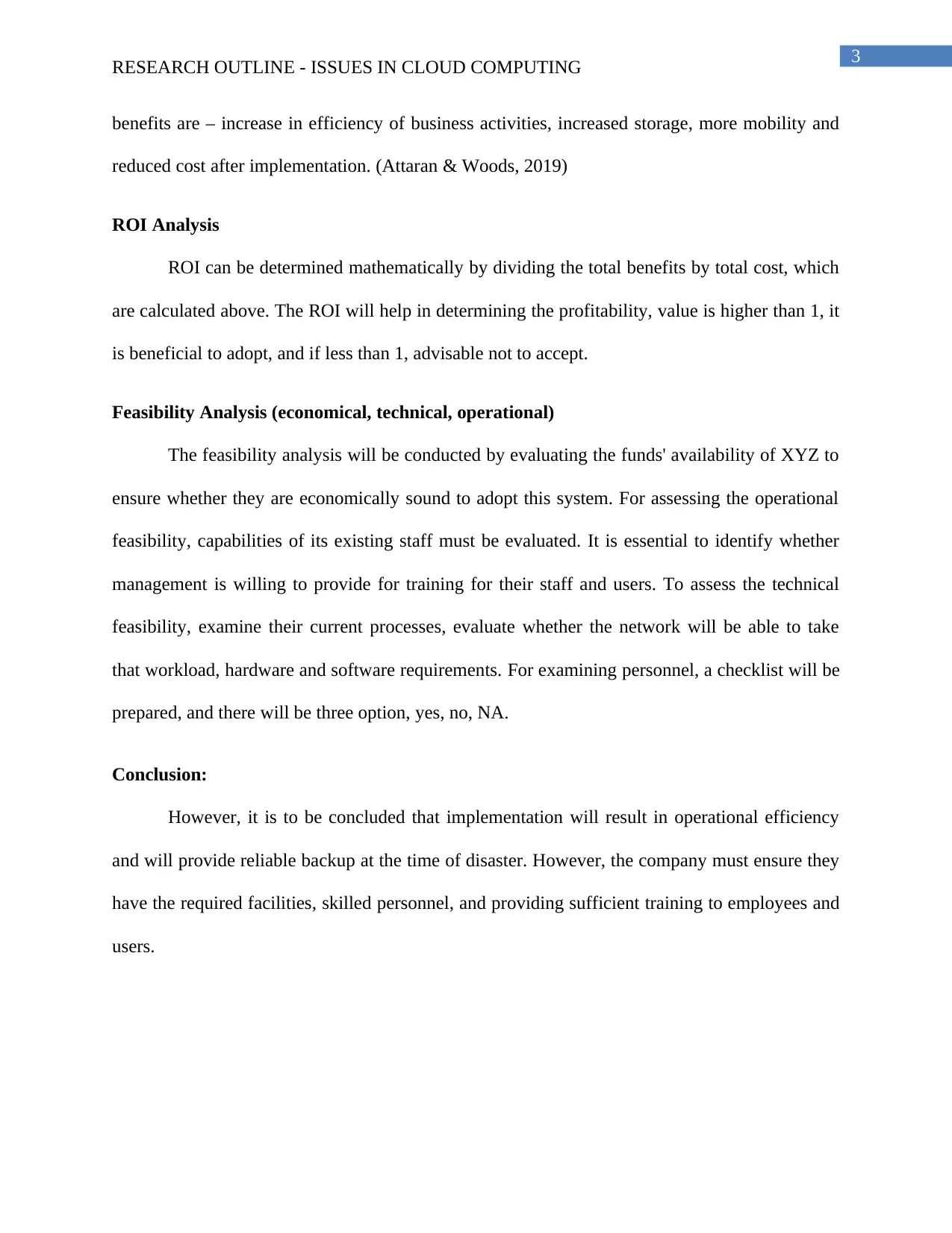
3
RESEARCH OUTLINE - ISSUES IN CLOUD COMPUTING
benefits are – increase in efficiency of business activities, increased storage, more mobility and
reduced cost after implementation. (Attaran & Woods, 2019)
ROI Analysis
ROI can be determined mathematically by dividing the total benefits by total cost, which
are calculated above. The ROI will help in determining the profitability, value is higher than 1, it
is beneficial to adopt, and if less than 1, advisable not to accept.
Feasibility Analysis (economical, technical, operational)
The feasibility analysis will be conducted by evaluating the funds' availability of XYZ to
ensure whether they are economically sound to adopt this system. For assessing the operational
feasibility, capabilities of its existing staff must be evaluated. It is essential to identify whether
management is willing to provide for training for their staff and users. To assess the technical
feasibility, examine their current processes, evaluate whether the network will be able to take
that workload, hardware and software requirements. For examining personnel, a checklist will be
prepared, and there will be three option, yes, no, NA.
Conclusion:
However, it is to be concluded that implementation will result in operational efficiency
and will provide reliable backup at the time of disaster. However, the company must ensure they
have the required facilities, skilled personnel, and providing sufficient training to employees and
users.
RESEARCH OUTLINE - ISSUES IN CLOUD COMPUTING
benefits are – increase in efficiency of business activities, increased storage, more mobility and
reduced cost after implementation. (Attaran & Woods, 2019)
ROI Analysis
ROI can be determined mathematically by dividing the total benefits by total cost, which
are calculated above. The ROI will help in determining the profitability, value is higher than 1, it
is beneficial to adopt, and if less than 1, advisable not to accept.
Feasibility Analysis (economical, technical, operational)
The feasibility analysis will be conducted by evaluating the funds' availability of XYZ to
ensure whether they are economically sound to adopt this system. For assessing the operational
feasibility, capabilities of its existing staff must be evaluated. It is essential to identify whether
management is willing to provide for training for their staff and users. To assess the technical
feasibility, examine their current processes, evaluate whether the network will be able to take
that workload, hardware and software requirements. For examining personnel, a checklist will be
prepared, and there will be three option, yes, no, NA.
Conclusion:
However, it is to be concluded that implementation will result in operational efficiency
and will provide reliable backup at the time of disaster. However, the company must ensure they
have the required facilities, skilled personnel, and providing sufficient training to employees and
users.
Paraphrase This Document
Need a fresh take? Get an instant paraphrase of this document with our AI Paraphraser
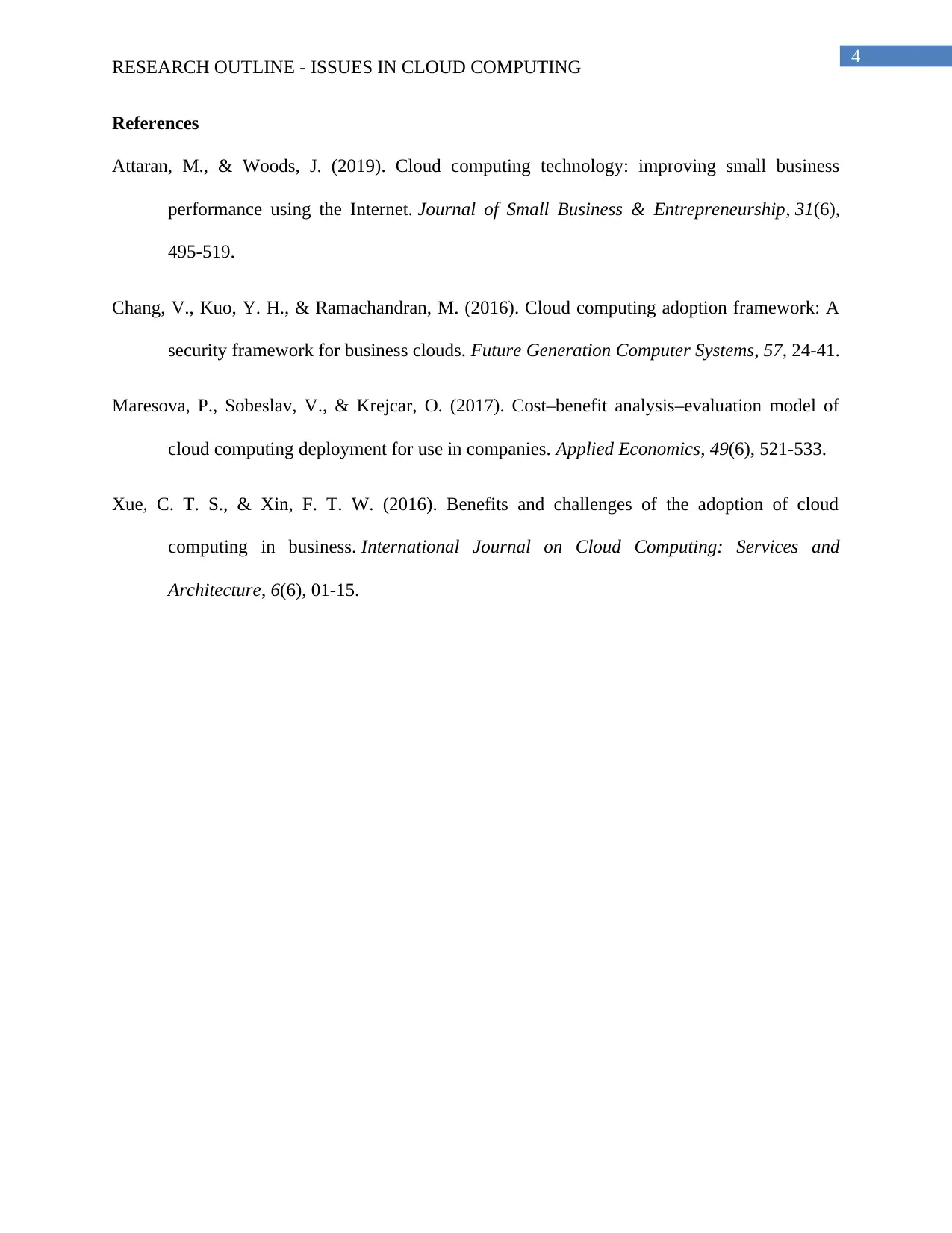
4
RESEARCH OUTLINE - ISSUES IN CLOUD COMPUTING
References
Attaran, M., & Woods, J. (2019). Cloud computing technology: improving small business
performance using the Internet. Journal of Small Business & Entrepreneurship, 31(6),
495-519.
Chang, V., Kuo, Y. H., & Ramachandran, M. (2016). Cloud computing adoption framework: A
security framework for business clouds. Future Generation Computer Systems, 57, 24-41.
Maresova, P., Sobeslav, V., & Krejcar, O. (2017). Cost–benefit analysis–evaluation model of
cloud computing deployment for use in companies. Applied Economics, 49(6), 521-533.
Xue, C. T. S., & Xin, F. T. W. (2016). Benefits and challenges of the adoption of cloud
computing in business. International Journal on Cloud Computing: Services and
Architecture, 6(6), 01-15.
RESEARCH OUTLINE - ISSUES IN CLOUD COMPUTING
References
Attaran, M., & Woods, J. (2019). Cloud computing technology: improving small business
performance using the Internet. Journal of Small Business & Entrepreneurship, 31(6),
495-519.
Chang, V., Kuo, Y. H., & Ramachandran, M. (2016). Cloud computing adoption framework: A
security framework for business clouds. Future Generation Computer Systems, 57, 24-41.
Maresova, P., Sobeslav, V., & Krejcar, O. (2017). Cost–benefit analysis–evaluation model of
cloud computing deployment for use in companies. Applied Economics, 49(6), 521-533.
Xue, C. T. S., & Xin, F. T. W. (2016). Benefits and challenges of the adoption of cloud
computing in business. International Journal on Cloud Computing: Services and
Architecture, 6(6), 01-15.
1 out of 5
Related Documents
Your All-in-One AI-Powered Toolkit for Academic Success.
+13062052269
info@desklib.com
Available 24*7 on WhatsApp / Email
![[object Object]](/_next/static/media/star-bottom.7253800d.svg)
Unlock your academic potential
Copyright © 2020–2025 A2Z Services. All Rights Reserved. Developed and managed by ZUCOL.





